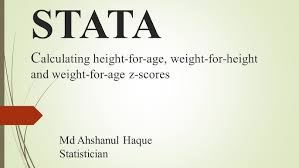Stata Z Score, is a statistical measure that describes a data point’s relationship to the mean of a group of data points. It is expressed as the number of standard deviations away from the mean. In simpler terms, the Z-score tells you how far a particular data point is from the average, allowing you to understand whether the data point is typical or an outlier.
Mathematically, the Z-score for a given data point XX is calculated using the formula:
Z=X−μσZ = \frac{X – \mu}{\sigma}
Where:
- ZZ = Z-score
- XX = Data point value
- μ\mu = Mean of the dataset
- σ\sigma = Standard deviation of the dataset
A Z-score of 0 means the data point is exactly at the mean, while a Z-score of +2 means the data point is two standard deviations above the mean. Conversely, a Z-score of -3 indicates that the data point is three standard deviations below the mean.
Why is the Z-Score Important?
The Z-score is valuable in a variety of situations:
- Comparing Different Datasets: Z-scores allow for the comparison of values from different datasets with varying scales and units. By converting raw scores into Z-scores, we can compare data points on a standardized scale.
- Identifying Outliers: Data points with very high or very low Z-scores (typically above +3 or below -3) are considered outliers. Identifying outliers is important for data cleaning and ensuring the integrity of the analysis.
- Assessing Probabilities: Z-scores are used in conjunction with the standard normal distribution (bell curve) to assess the probability of a data point occurring. This is especially useful in hypothesis testing and confidence intervals.
- Standardizing Data: When working with datasets containing variables of different units or scales, converting raw data to Z-scores standardizes all variables, making them comparable.
Calculating the Z-Score in STATA
In STATA, calculating the Z-score is a straightforward process. Let’s walk through the steps involved:
1. Load Your Data
Before you can calculate the Z-score, you need to load your dataset into STATA. Assuming you already have your data in a file, use the use command to load it:
Here, dataset.dta is the name of your dataset file.
2. Calculate the Mean and Standard Deviation
STATA provides built-in functions for calculating the mean and standard deviation of a variable. For example, if you have a variable income and want to calculate its Z-scores, first compute the mean and standard deviation:
This will provide you with the mean (μ\mu) and standard deviation (σ\sigma) of the income variable.
3. Calculate the Z-Score
To calculate the Z-score for a variable, STATA has a built-in command egen (extended generate), which allows you to generate new variables. You can use egen to create a new variable representing the Z-scores.
For example, to calculate the Z-score for the variable income, use the following command:
This command creates a new variable z_income that contains the Z-scores for the income variable. The std() function standardizes the data by subtracting the mean and dividing by the standard deviation.
4. View the Results
Once the Z-scores are calculated, you can view the results in your dataset by using the list command:
This will display the original income values alongside their corresponding Z-scores (z_income).
Example: Z-Score Calculation in STATA
Let’s consider an example where you want to calculate the Z-scores for a dataset containing students’ exam scores. Suppose the variable score represents the scores, and you want to calculate the Z-scores.
- Load the dataset:
- Calculate the Z-scores:
- View the results:
In this case, each student’s z_score would tell you how far their score is from the mean score of the group in terms of standard deviations.
Applications of the Z-Score
The Z-score is used in many areas of research, business, and data analysis. Here are some of the common applications:
1. Finance and Risk Management
In finance, Z-scores are often used to assess the relative performance of investments. The Z-score model (also known as the Altman Z-score) is a famous model used to predict corporate bankruptcy by analyzing financial ratios. A Z-score below a certain threshold suggests a higher probability of bankruptcy.
2. Healthcare and Medical Research
In medical research, Z-scores are used to standardize various health metrics, such as body mass index (BMI), cholesterol levels, or blood pressure. For example, a Z-score might help doctors assess whether a patient’s cholesterol level is significantly higher or lower than the average population value, given the standard deviation of cholesterol levels.
3. Quality Control in Manufacturing
In quality control, Z-scores help manufacturers assess whether their products meet quality standards. If a product’s measurement (e.g., length, weight, etc.) is far from the mean value, it may indicate a defect or inconsistency in the production process.
4. Psychometrics and Education
Z-scores are used in educational testing to standardize student performance. For example, a Z-score can be used to compare the performance of students in different schools or countries on standardized tests, taking into account the differences in average scores and standard deviations.
5. Social Sciences and Psychology
Researchers in social sciences and psychology often use Z-scores to standardize survey responses, personality traits, or psychological test scores. Z-scores allow for meaningful comparisons across different groups or populations.
Conclusion
The Z-score is a fundamental concept in statistics, helping to standardize and interpret data across different distributions. In STATA, calculating the Z-score is a simple process that involves using the egen command with the std() function. Z-scores are used in a wide variety of fields, from finance to healthcare, social sciences, and beyond. By converting raw data into a standardized form, Z-scores make it easier to compare values, identify outliers, and draw meaningful insights from data.
Whether you are analyzing exam scores, evaluating financial risks, or standardizing measurements, understanding how to calculate and interpret Z-scores is a valuable skill in data analysis.




